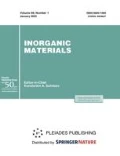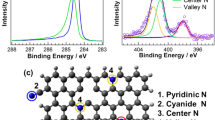Abstract
Earlier and new results on spontaneous and electrochemical intercalation reactions of highly oriented pyrolytic graphite and nitric acid in a wide range of HNO3 concentrations are summarized and analyzed. The oxidizing capacity of the solution is shown to determine the extent of intercalation and the stage index of the resulting graphite intercalation compound (GIC), as in the graphite–H2SO4 system. The final potential of graphite nitrate after spontaneous intercalation coincides with the potential E Ag/AgCl in HNO3 . During the reaction of graphite with an HNO3 solution, the potential of graphite nitrate varies monotonically, in contrast to the steplike variation inE in the C–H2SO4–oxidant system. The behaviors of Brönsted acids which can and cannot spontaneously intercalate into graphite are compared. It is shown that the anodic polarization of graphite in HNO3 offers the possibility of controlling the potential and stage index of the resulting GIC by varying the HNO3 concentration and current. During anodic polarization in 75–98% HNO3 at I= 30–100 μA, the interplay between the spontaneous and electrochemical oxidation processes leads to the formation of stage II graphite nitrate, irrespective of the charge passed, and notably reduces the intercalation rate. This effect is interpreted in terms of the intercalation mechanism and sorption processes. The data on the anodic polarization of graphite at small currents point to fundamental differences in electrochemical behavior between the intercalants that can (HNO3) and cannot (H2SO4) spontaneously intercalate into graphite. The concentration ranges and potentials of the formation of stage I and II graphite nitrates via anodic oxidation in HNO3 are determined. The electric current is shown to influence the potential of formation of the stage I GIC: the minimal potential of graphite nitrate formation in 98% HNO3 is E Ag/AgCl = 1.34 V (I= 500 μA). The potentialities of the spontaneous and electrochemical intercalation reactions for the controlled synthesis of graphite nitrate with a particular stage index are compared.
Similar content being viewed by others
REFERENCES
Rudorff, W. and Hofmann, U., Uber Graphitsaltse, Z. Anorg. Allg. Chem., 1938, vol. 238, no. 1, pp. 1-50.
Chernysh, I.G., Karpov, I.I., Prikhod'ko, V.P., and Shai, V.M., Fiziko-khimicheskie svoistva grafita i ego soedinenii (Physicochemical Properties of Graphite and Its Compounds), Kiev: Naukova Dumka, 1990.
Herold, A., Crystallo-Chemistry of Carbon Intercalation Compounds, Intercalation Layer Mater., 1979, vol. 6, pp. 321-328.
Forsman, N.S., Vogel, F.L., Carl, D.E., et al., Chemistry of Graphite Intercalation by Nitric Acid, Carbon, 1978, vol. 16, pp. 269-271.
Scharff, P., Xu, Z.-Y., Stumpp, E., et al., Reversibility of the Intercalation of Nitric Acid into Graphite, Carbon, 1991, vol. 29, no. 1, pp. 31-37.
Avdeev, V.V., Tverezovskaya, O.A., Sorokina, N.E., et al., Electrochemical Study of the Graphite-HNO3 System, Neorg. Mater., 2000, vol. 36, no. 3, pp. 276-281 [Inorg. Mater. (Engl. Transl.), vol. 36, no. 3, pp. 214?218].
Avdeev, V.V., Sorokina, N.E., Tverezovskaya, O.A., et al., Synthesis and Physicochemical Properties of Intercalation Compounds in the Graphite-HNO3 System, Neorg. Mater., 1999, vol. 35, no. 4, pp. 435-439 [Inorg. Mater. (Engl. Transl.), vol. 35, no. 4, pp. 348?351].
Avdeev, V.V., Sorokina, N.E., Nikol'skaya, I.V., et al., Synthesis of Intercalation Compounds in the System Graphite-HNO3-H2SO4, Neorg. Mater., 1997, vol. 33, no. 6, pp. 699-702 [Inorg. Mater. (Engl. Transl.), vol. 33, no. 6, pp. 584-587].
Orlova, E.Yu., Khimiya i khimicheskaya tekhnologiya vzryvchatykh veshchestv (Chemistry and Chemical Technology of Explosives), Leningrad: Khimiya, 1973.
Avdeev, V.V., Martynov, I.U., Nikolskaya, I.V., et al., Investigation of the Graphite-H2SO4-Gaseous Oxidizer (Cl2, O3, SO3) System, J. Phys. Chem. Solids, 1996, vol. 57, nos. 6-8, pp. 837-840.
Avdeev, V.V., Tverezovskaya, O.A., Sorokina, N.E., et al., Synthesis and Analysis of the Behaviour of Graphite Nitrate in H2O, CH3COOH, and Their Mixtures, Proc. ISIC 10, Okazaki, 1999, p. 71.
Avdeev, V.V., Monyakina, L.A., Nikol'skaya, I.V., et al., Chemical Synthesis of Graphite Hydrogenosulfate: Calorimetry and Potentiometry Studies, Carbon, 1992, vol. 30, no. 6, pp. 825-827.
Avdeev, V.V., Tverezovskaya, O.A., and Sorokina, N.E., Spontaneous and Electrochemical Intercalation of HNO3 into Graphite, Proc. ISIC 10, Okazaki, 1999, p. 72.
Beck, F., Krohn, H., and Kaiser, W., Galvanostatic Cycling of Graphite Intercalation Electrodes with Anions in Aqueous Acids, J. Appl. Electrochem., 1982, vol. 12, pp. 505-515.
Author information
Authors and Affiliations
Rights and permissions
About this article
Cite this article
Sorokina, N.E., Monyakina, L.A., Maksimova, N.V. et al. Potentials of Graphite Nitrate Formation during Spontaneous and Electrochemical Graphite Intercalation. Inorganic Materials 38, 482–489 (2002). https://doi.org/10.1023/A:1015423105964
Issue Date:
DOI: https://doi.org/10.1023/A:1015423105964




